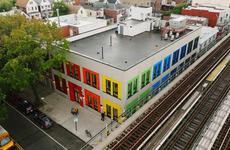
IBUKU's Kindergarten Design Addresses the Young Students' Needs
Joey Haar — January 3, 2018 — Life-Stages
References: archdaily
Unlike more traditional classroom designs, which feature rows of desks all geared toward the front of the class, kindergarten design needs to recognize the students therein. Kindergarten students are very young children, meaning that they can't be reasonably expected to sit in orderly attention as older students can. Fortunately, the kindergarten design at Green School in Bali, Indonesia, addresses that concern.
The classroom is a circle that revolves around a bright central bamboo column, and the various play and storage areas throughout the classroom are embedded into the outer walls. Because of its circular shape, the classroom inherently recognizes that kindergarten-aged children will roam and play more often than they'll be sitting listening to lessons from their teachers. The space also features a bamboo archway as the door area, showing children the harmony between the outdoor environment and indoor space.
The classroom is a circle that revolves around a bright central bamboo column, and the various play and storage areas throughout the classroom are embedded into the outer walls. Because of its circular shape, the classroom inherently recognizes that kindergarten-aged children will roam and play more often than they'll be sitting listening to lessons from their teachers. The space also features a bamboo archway as the door area, showing children the harmony between the outdoor environment and indoor space.
Trend Themes
1. Circular Kindergarten Classrooms - Designing kindergarten classrooms as a circle that revolves around a central column offers a distraction-free play area for children.
2. Embodied Learning Design - Incorporating play and storage areas into the outer walls of kindergarten classrooms, supports an embodied, climbing and exploring style of learning.
3. Nature-inspired Design for Kids - Using natural and sustainable materials such as bamboo for classroom design helps to create a harmonious indoor-outdoor environment for young learners.
Industry Implications
1. Education Industry - Kindergarten classroom designs that favor an embodied, distraction-free style of learning could transform how we educate younger children.
2. Architectural Design Industry - Modifying traditional classroom design for the specific requirements of young learners offer opportunities for innovative architectural designs.
3. Eco-friendly Design Industry - Nature-inspired, environmentally sustainable designs could become the norm in the kindergarten building industry.
5.5
Score
Popularity
Activity
Freshness























